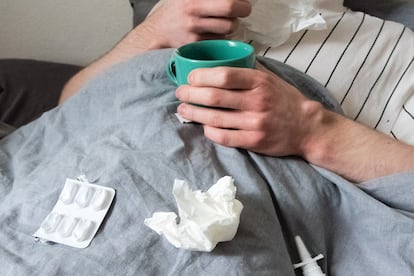More sensitive or more watchful? Why it seems like everyone has a cold
The feeling of being caught in a never-ending cycle of infection has been reinforced by the pandemic, but epidemiologists say respiratory viruses have not become more aggressive

Many conversations these days revolve around the fact that a family member, friend or co-worker has a stuffy nose, cough, cold, or all of these symptoms at once. As winter sets in, the impression that everyone ends up getting sick happens every year. The cold weather and lack of ventilation in enclosed spaces means viruses such as influenza and Covid find the ideal conditions in which to flourish. The feeling of being trapped in a never-ending cycle of infection at this time of year has been reinforced by the pandemic, a period when masks and social distancing not only protected the population from Covid-19 but also from the flu. But is it true that colds are hitting us harder and more often than before?
“It is normal for the number of cases to increase at this time of year, and continue to do so,” explains Dr. Leovigildo Ginel, secretary of the working group on respiratory diseases at the Spanish Society of Primary Care Physicians. “In health centers, many patients come in with colds and respiratory infections, but the cases are mostly not serious.” Ginel stresses that it is to be expected that, after the winters during the pandemic when influenza, colds and common colds practically disappeared to be replaced by Covid-19, our immune system has to get used to more viruses.
As far as the experts know, respiratory viruses have not become more aggressive in recent years. Epidemiologist Toni Trilla from the Barcelona Hospital Clinic identifies a plausible cause in the so-called “immune debt.” “As we have not been exposed to other pathogens during the coronavirus era, they could hit us harder now that they are back in circulation because we have been out of practice,” he points out. Considering containment measures such as masks and social distancing have been dropped, the population is once again exposed to viruses to which it is not accustomed.
“When a virus like SARS-CoV-2 circulates, it is normal for the others to stop circulating; this is what is called ecological competition,” says Magda Campins, head of preventive medicine at Vall D’Hebron Hospital (Spain). Bearing in mind that during a normal flu season, 25% of the population catches the flu, the epidemiologist estimates that in the next two or three years, the population will have recovered pre-pandemic immunity levels. “This calculation clearly does not apply to very young children, who do not achieve the levels of immunity acquired by adults until they are six,” she adds.
Both natural immunity, that develops post-infection, and vaccine immunity is limited as viruses mutate frequently. “It is possible that a person who has been exposed to the circulating virus this year will no longer be protected next year,” says Campins. “That is why vaccination is always a good idea, even for younger people who have no previous pathologies.” More than 70% percent of the world population has received a Covid-19 vaccine. This year also marks the first vaccination campaign for babies against RSV, which causes the vast majority of bronchiolitis cases in infants and leads to one in 56 babies with it being admitted to hospital.
More viruses in circulation
One of the things that has changed is the landscape of viral circulation, which has become more complex since the coronavirus. “It’s never going to go back to how it was before Covid,” says Amparo Larrauri, head of the surveillance group for influenza and other respiratory viruses at the National Epidemiology Center at the Carlos III Health Institute (Spain). “SARS-CoV-2 is here to stay and is competing with other viruses at this time of year.” Larrauri explains that in the last two seasons, during the months of October to December, influenza viruses, SARS-CoV-2 and RSV, are circulating at the same time, which could lead people to believe there are a greater number of respiratory infections among the population.
The idea we are sicker is also being reinforced by the fact we are more aware. Experts stress that after the pandemic, when a slight cough was enough to set off alarm bells, the population has been sensitized to the risks. “We are aware of the symptoms, and if we have Covid we worry about visiting our grandparents,” says Salvador Peiró, director of Fisabio’s Health Services Research Area in Valencia, Spain.
Julián Domínguez, head of the Preventive Medicine Service at Ceuta Hospital, acknowledges that every time there is a new epidemic, when the number starts to grow, the feeling that everyone is ill grows too. “When two or three infected patients coincide at the same time on a hospital ward, it is said there are a lot of infected patients, although in fact the data is absolutely normal in the weeks before or after,” he says.
Sign up for our weekly newsletter to get more English-language news coverage from EL PAÍS USA Edition
Tu suscripción se está usando en otro dispositivo
¿Quieres añadir otro usuario a tu suscripción?
Si continúas leyendo en este dispositivo, no se podrá leer en el otro.
FlechaTu suscripción se está usando en otro dispositivo y solo puedes acceder a EL PAÍS desde un dispositivo a la vez.
Si quieres compartir tu cuenta, cambia tu suscripción a la modalidad Premium, así podrás añadir otro usuario. Cada uno accederá con su propia cuenta de email, lo que os permitirá personalizar vuestra experiencia en EL PAÍS.
¿Tienes una suscripción de empresa? Accede aquí para contratar más cuentas.
En el caso de no saber quién está usando tu cuenta, te recomendamos cambiar tu contraseña aquí.
Si decides continuar compartiendo tu cuenta, este mensaje se mostrará en tu dispositivo y en el de la otra persona que está usando tu cuenta de forma indefinida, afectando a tu experiencia de lectura. Puedes consultar aquí los términos y condiciones de la suscripción digital.
More information
Archived In
Últimas noticias
Half of Scotland is in the hands of 420 property owners
Reinhard Genzel, Nobel laureate in physics: ‘One-minute videos will never give you the truth’
Pinochet’s victims grapple with José Antonio Kast’s rise in Chile
From digital curfews to blocking apps: How technology experts protect their children online
Most viewed
- Pablo Escobar’s hippos: A serious environmental problem, 40 years on
- Reinhard Genzel, Nobel laureate in physics: ‘One-minute videos will never give you the truth’
- Why we lost the habit of sleeping in two segments and how that changed our sense of time
- Charles Dubouloz, mountaineering star, retires at 36 with a farewell tour inspired by Walter Bonatti
- The Florida Keys tourist paradise is besieged by immigration agents: ‘We’ve never seen anything like this’











































